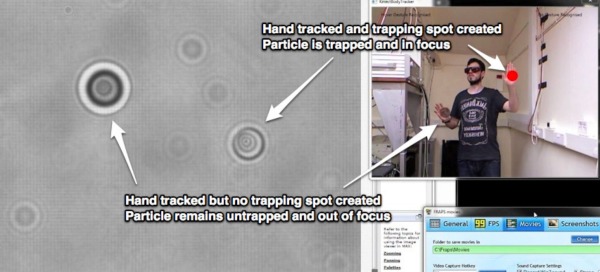University Researchers Use Xbox Kinect To Control Lasers

Researchers at the University of Dundee have used the Xbox 360 Kinect sensor to control optical tweezers, a set of laser beams used to manipulate particles.
Physicists control the particles through their body movements, which are read by a Kinect-based interface called "HoloHands." While not completely perfect yet, with a latency issue and the occasional misinterpration of the user's movements, the interface has been quite successfully tested moving silica particles.
Users can pick up and push minuscule particles visible on a computer screen by moving their bodies. By waving their hand, users can create a trapping region to hold the particles which can then be picked up and moved with further arm and hand movements.
Optical tweezers have been in scientific use since the 1970s, and have been difficult to control in the past. But team leader Dr. David McGloin believes that this Xbox Kinect interface shows potential, whereas the many ways presented in the past hadn't so much.
Team leader Dr. David McGloin noted the Kinect's potential with optical tweezers, which have been used in labs since the 1970s as a way to interact with individual particles on the microscopic level and which have been somewhat difficult to control in the past.
"We have a lot of video game enthusiasts here, and we came to the conclusion that Kinect had the potential to allow us to build a very natural and intuitive interface that would appeal to a wide range of potential users," explained Dr McGloin.
"We're always open to new ways of working and keeping an open mind about these things is essential in science. This shows how technology that at first seems as far removed from the academic lab as it’s possible to be, can actually be of great benefit to us."
While the gaming success of the Kinect has been somewhat sketchy, the uses outside of the Xbox 360 have shown a widespread application for motion control. The peripheral has been used to recreate the feeling of being underwater, made a 3D holographic computer interface, and control the 'board of awesomeness.'
Dr McGloin and his team are carrying out further work to fix the bugs and work out how to perform quantitative measurements, alongside this specifying the many other use cases they had imagined.
"In addition, Kinect control of such devices opens them up to use in areas such as science centres and exhibitions, as well as in other forms of outreach activities. Using familiar devices such as this and showing how the technology is the same as used in labs will undoubtedly help to engage with members of the public and explain our work to them."
Source: University of Dundee, arXiv
Jason England

